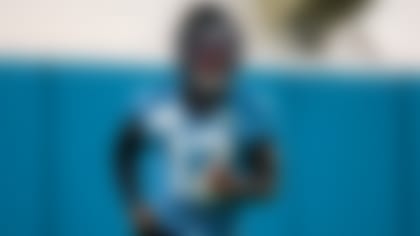Numbers don't lie -- but neither does the well-trained eye. Seasoned football watcher Chris Wesseling and Next Gen Stats maven Nick Shook provide their All-Pro Teams from the 2018 NFL season.
Quarterback
Chris Wesseling: Patrick Mahomes, Kansas City Chiefs. The story of the season, Mahomes led the Chiefs to 26 or more points in all 17 of his starts as a first-time starter -- the second-longest such uninterrupted streak in NFL history. He found the end zone at a higher rate (8.6 percent of his passes) than Peyton Manning did (8.3) in setting a record with 55 touchdowns in 2013. The more we view sports through the lens of analytics, the more we allow this overflow of information to overwhelm our eyes. Watching all 32 teams week in and week out, my eyes offered a convincing argument that no other quarterback could expand the possibilities on a given play to the extent that Mahomes could -- via escapability, creativity, vision and unmatched arm strength. In terms of pure talent, Aaron Rodgers is no longer alone at the top.
Nick Shook: Drew Brees, New Orleans Saints. While Mahomes' season was undoubtedly stellar, Brees shined in nearly all of Next Gen Stats' advanced QB metrics. Among qualified passers, Brees posted the highest differential between completion percentage and expected completion percentage at plus-7.4 percent. He also topped Mahomes in passer rating (115.7 vs. 113.8) and tight-window throw percentage (15.5 percent vs. 12.2 percent) while his targeted receivers were open at a lower rate than Mahomes' (40.9 percent vs. 49.3 percent) and achieved less separation per attempt (3.1 yards vs. 3.5). The two QBs were comparable in air yards per attempt (7.1 for Brees, 9.2 for Mahomes) and air distance per attempt (20.2 for Brees, 21.2 for Mahomes). Brees finished with 1,105 fewer passing yards than Mahomes, a product of Brees targeting receivers running shorter routes, as evidenced by his quicker time to throw (2.59 seconds versus Mahomes' 2.91 seconds) and the fact that a smaller percentage of his passing yardage came after the catch (47.3 percent vs. 53.6 percent). He also threw less than half as many picks (five) as Mahomes did (12), which can be chalked up to Brees attempting 91 fewer passes. The biggest advantage for Brees in these metrics: QB pressures. Brees was pressured on just 18.2 percent of attempts, as opposed to Mahomes' 30 percent, which can again be partially attributed to Brees' quicker release. In all, Brees didn't put up the gaudy totals of Mahomes, but he proved to be even more effective when it came to Next Gen Stats.
Running back
Wesseling: Ezekiel Elliott, Dallas Cowboys. Is it unfair that Todd Gurley got squeezed off of this list? Sure. Just as it's unfair that Drew Brees couldn't be shoehorned into one quarterback slot. My game notes throughout the first three months of the season tout Gurley as the gold standard at his position, combining decisive cuts and casual tackle-shedding with breakaway speed in the open field and the power to pull defensive linemen past the sticks in short-yardage situations. Give me another running back spot, and I will be overjoyed to list Gurley alongside Elliott. He is, after all, an All-Pro talent at the height of his powers. Whereas C.J. Anderson jumped off his couch to emulate Gurley's production as a late-season stand-in, Elliott is simply irreplaceable in Dallas' offense, averaging an astonishing 1.86 more yards per carry than all other Cowboys backs. A much bigger part of the passing game this year, Elliott uses uncanny instincts, patience and power to function as the engine that makes his otherwise sluggish offense go.
Shook: Ezekiel Elliott, Dallas Cowboys. Elliott takes the crown here because of how well he overcame the disadvantage he was facing, especially before Dallas acquired Amari Cooper in October. On the season, Elliott ran against loaded boxes on 38.5 percent of his attempts and faced boxes with eight-plus defenders on 24.7 percent of his attempts. Among players with at least 200 carries, only Seattle's Chris Carson (57.9 percent), Houston's Lamar Miller (41.9 percent), Tennessee's Derrick Henry (40.5 percent), Chicago's Jordan Howard (40.4 percent) and Tampa's Peyton Barber (38.9 percent) faced more loaded boxes, and none came close to sniffing Elliott's league-leading yardage total of 1,434. Additionally, Elliott led the same group of rushers in 10-plus-yard runs (41), a sign that Elliott was able to move the chains by himself -- a big reason for Dallas' offensive success. And consider how much more difficult his life was in the nearly half-season he was without Cooper. In the seven games before the Cooper trade, the Cowboys used 11 personnel -- which was a favorable grouping for Elliott, who faced stacked boxes on just 2 percent of plays in 11 personnel -- on just 53 percent of plays, 28th most in the NFL in that span.
Wide receivers
Wesseling: DeAndre Hopkins, Houston Texans; Michael Thomas, New Orleans Saints. A pair of physical box-out artists with uncommonly strong hands, Hopkins and Thomas play like Larry Fitzgerald in his prime. Hopkins has been the league's premier boundary receiver for the past few years, specializing in highlight-reel catches on the sideline and in the corner of the end zone. His 115 receptions this season were the most ever without a drop. For long stretches of the season, a pass to Thomas was the most reliable completion in football. He's a one-man positive outcome.
Shook: Michael Thomas, New Orleans Saints; DeAndre Hopkins, Houston Texans. Only three receivers reached double-digits in the differential between their catch percentage and their expected catch percentage: Thomas (16.2 percent), Hopkins (11.2) and Minnesota's Adam Thielen (10.2). Thomas and Hopkins each enjoyed 2.7 yards of separation or less per target on average. Thomas dominated in passer rating on targeted passes, leading all receivers with at least 100 targets with 124.1, thanks in part to the fact that he received throws from Drew Brees. Hopkins, meanwhile, finished in fourth (115.9), behind only Thomas, Tyler Boyd (122.0) and Davante Adams (116.6). Hopkins was only wide open on 11.7 percent of his targets and Thomas' number is even lower at 10.2 percent, meaning they overcame at least somewhat challenging circumstances to post their eye-popping numbers. Truly, only four receivers merited consideration for this: Thomas, Hopkins, Thielen and Atlanta's Julio Jones. There are only two slots, so the first two get the nods.
Flex
Wesseling: Tyreek Hill, Kansas City Chiefs. Over the past two seasons, Ezekiel Elliott, DeAndre Hopkins and Tyreek Hill have been the three skill position stars most crucial to their team's success. Saints luminaries Drew Brees and Sean Payton agree, telling NBC Sports' Peter King in mid-November that Hill is the most dangerous player in football right now. Like Randy Moss in his prime, Hill allows the rest of the offense to feast off the open spacing provided by his rare, game-breaking speed.
Shook: Saquon Barkley, New York Giants. If it wasn't for Baker Mayfield resetting the rookie passing TD record in less than a full season, Barkley would be the runaway favorite for Offensive Rookie of the Year. Barkley finished with 1,307 yards rushing on 261 carries (5.0 yards per carry), and averaged 4.5 yards gained after a defender closed within 1 yard, just 0.24 yards off Alvin Kamara's average as a rookie in 2017. He wasn't working with a great offensive line, either, averaging 0.5 yards gained before a defender closed within a yard. He also tied Odell Beckham for most receptions as a rookie with 91 -- and did so as a running back. Barkley was the most prominent ray of hope in a dim season for the Giants, thanks to his do-it-all ability, and while he did disappear in a few games, his total production cannot be overlooked.
Tight end
Wesseling: Travis Kelce, Kansas City Chiefs. Now that GOAT Gronkowski has reached the lumbering stage of a Hall of Fame career, there are three viable contenders for the tight end crown. Philadelphia's Zach Ertz is the most sure-handed of the trio but is dinged for subpar blocking. San Francisco's George Kittle, on the other hand, is an excellent blocker, an elusive open-field runner and the new record-holder for yards in a season by a tight end. Play-caller supreme Kyle Shanahan earns a fair share of that credit for scheming open the prairie land in which Kittle roams. I chose Kittle for midseason honors and have no issue with anyone giving him the nod now. I ultimately sided with Kelce for red-zone prowess and a more consistent ability to move the chains.
Shook: Travis Kelce, Kansas City Chiefs. I tried very much to give this selection to Zach Ertz or George Kittle, and while they're both excellent tight ends, they just don't bring the same complete Next Gen resume that Kelce slides across the interview table with such confidence. The only thing better than Kelce's dance moves is his ability to overcome an evident focus on the part of opposing defenses to contain him. Of those three tight ends, Kelce enjoyed the least amount of average separation (2.9 yards), open targets (39.3 percent) and wide open targets (14.7 percent). He enjoyed a 110.3 passer rating when targeted, posted the second-best differential between expected and actual catch percentage (plus-4.2), finished second in touchdowns -- 10, on just 10 end zone targets for the entire season -- and finished second in yards. He'd have led the latter category had Kittle not exploded in the final month of the season. We spend plenty of time gushing over Patrick Mahomes and Tyreek Hill, but Kelce is an integral part of Kansas City's high-flying offense. He's earned that McDonald's commercial.
Tackles
Wesseling: David Bakhtiari, Green Bay Packers; Mitchell Schwartz, Kansas City Chiefs. I reached out to USA Football's offensive line scout, Brandon Thorn, who confirmed that Bakhtiari and Schwartz were "just masterful" in pass protection this season. Thorn was especially impressed with Schwartz, who is not a great athlete yet shuts down the game's most dynamic edge rushers with "spectacular" technique. If not for injuries and an offensive slump that lasted throughout December, the Saints' tandem of Terron Armstead and Ryan Ramczyk might have claimed these two spots.
Shook: David Bakhtiari, Green Bay Packers; Andrew Whitworth, Los Angeles Rams. Next Gen is still lacking in this department, primarily because tracking data isn't going to tell you if someone was beaten in pass protection or failed to execute a block. It'll just tell you that they likely made contact. In mixing the eye test with the advanced metrics, though, we can get a decent idea of who deserves this attention. We'll take into account three key factors, viewed through the lens of effective passers with at least 200 attempts: pressure rate, time to throw and sacks allowed. Toss in the relative mobility of the passer in question and league-wide reputations for individual tackle performances in 2018 to make this assessment, and it's clear Bakhtiari deserves this nod. Green Bay owned the fourth-highest average time to throw in the league at 2.96 seconds, yet allowed a pressure on Aaron Rodgers on just 21.1 percent of dropbacks, sixth-lowest in the NFL. That means the Packers are sustaining their blocks longer than any other team in the league at the most efficient rate, an effort led by Bakhtiari. The next team on the list in time to throw? The Rams (2.94 seconds), who use a healthy amount of play action out of 11 personnel, requiring more time for Jared Goff to complete his fake and usually increasing the difficulty of sustaining a long pass block. As a team, the Rams allowed Goff to be pressured on just 23.7 percent of dropbacks, good for 10th best in the NFL. Whitworth is as reliable as they come, allowing just four sacks on 638 snaps, per Pro Football Focus.
Guards
Wesseling: Zack Martin, Dallas Cowboys; Quenton Nelson, Indianapolis Colts. Those of us who grew up in the 1980s recall Penn State's defensive dominance that led to the nickname "Linebacker U." With Martin and Nelson threatening to dominate the two All-Pro spots for the next half-decade, Notre Dame may soon be recognized as "Guard U." Martin turned in his finest work yet as the anchor for an offensive line that lost All-Pro center Travis Frederick and broke in an often-overmatched rookie at the other guard spot in Connor Williams. Despite all of the changes up front, Ezekiel Elliottstill reigns as the NFL's rushing leader. A punchline throughout the Andrew Luck era, the Colts' offensive line is suddenly among the NFL's most stout now that Nelson is setting a nasty tone, bulldozing multiple tacklers in the ground attack and stonewalling interior rushers in pass protection.
Shook: Quenton Nelson, Indianapolis Colts; Joel Bitonio, Cleveland Browns. We'll use the same process to identify the best interior linemen, though one half of this was a runaway. Luck was pressured on just 22.1 percent of dropbacks, seventh-best in the NFL, and sacked just 18 times for an entire season. A big part of that was Nelson, who swept All-Pro and Pro Bowl honors in his first professional season and is on track to become one of the best guards in history. Yes, that's high praise and an even higher bar to set, but he's that good. Bitonio went overlooked amid BakerMania in Cleveland, but the Next Gen Stats back it up: Cleveland allowed pressures on Mayfield on just 18.4 percent of dropbacks, fourth-best in the NFL, while Mayfield averaged a time to throw of 2.79 seconds. Most of the credit is due to the interior trio of Kevin Zeitler, JC Tretter and Bitonio. Bitonio was the No. 6 pass blocker among all tackles, guards and centers in the NFL in terms of overall grade, allowed just one sack on 694 snaps (Zeitler allowed just four in the same amount of snaps) and posted a pass blocking efficiency rate of 98.8 percent, per PFF. Cleveland also landed in the top 14 in 10-plus-yard run percentage at 13.4 percent, though their rushing metrics weren't as sharp.
Centers
Wesseling: Jason Kelce, Philadelphia Eagles. An undersized pivot, Kelce has always been long praised for his athleticism, especially on screen plays. While he remains an unsurpassed blocker in space, he has also rounded out his game over the past couple of years. The Raiders' Rodney Hudson, Bears' Cody Whitehair and Colts' Ryan Kelly also enjoyed Pro Bowl-caliber seasons in 2018.
Shook: Jason Kelce, Philadelphia Eagles. Kelce is the cream of the crop at the position, leading a group that saw seven linemen get involved due to injuries and coaching decisions and weathering a storm that included switching quarterbacks late in the season. No one knows a center better than the man putting his hands underneath him to receive the snap, and Kelce was as reliable as ever, whether it was Carson Wentz or Nick Foles lining up behind him. We can't separate pass protection stats by individuals, but as a group, Philadelphia landed near the middle of the pack in pressures allowed (27.7 percent). The positives: Eagles passers posted a combined rating of 100.7, were 3.9 percent better than their expected completion percentage and helped Philadelphia land in the Divisional Round before exiting. This portion of the exercise is always more reliant on the eye test, and as someone whose niche calls for plenty of film study of offensive lines, I can say with confidence that Kelce is the home run choice here.
Kicker
Wesseling: Justin Tucker, Baltimore Ravens. Unlike last year in which the Rams' Greg Zuerlein authored one of the magical kicking seasons of the past decade, no one booted well enough this season to unseat the position's reigning master craftsman. The Jets' Jason Myers was hot on Tucker's trail until he missed three kicks in a pair of close December losses. The Giants' Aldrick Rosas enjoyed a Pro Bowl campaign himself, missing just one field goal and extra point apiece.
Shook: Jason Myers, New York Jets. I was stunned when Myers made the Pro Bowl over Tucker, but a deeper dive into how he made 33 of his 36 field goals reveals the stellar season Myers enjoyed. With apologies to my colleague Jeremy Bergman, Myers was at a bit of a disadvantage being on the Jets, who didn't give him many chip shots. Myers made 13 of 14 attempts from 30-39 yards, and 10 of 11 attempts from 40-49 yards. Oh, and he was 6 for 7 from 50-plus. The only legitimate ding against him is his 30 for 33 mark on PATs, but we can't all be perfect.
Returner
Wesseling: Andre Roberts, New York Jets.Cordarrelle Patterson and Tyreek Hill are limited to kickoffs and punts, respectively, whereas Roberts was a dynamic returner at both spots. As much as I'd like to reward Tarik Cohen for carrying the Bears' offense this year, this is a special teams honor.
Shook: Andre Roberts, New York Jets. Miami's Jakeem Grant is a home run threat every time he fields a return, but Roberts' totals are overwhelming. His 1,174 kick return yards produced a 29.4 yards per return average to go with one kick return touchdown, and only Tarik Cohen posted a higher punt return yardage total than Roberts' 324 yards. Roberts was also just one of two returners to record a kick return touchdown and a punt return touchdown in 2018, with the other being Grant.











